In the face of a foreign culture people tend to simplify its cuisine, narrowing it down to an easy to navigate package of dishes we order again and again. Take Thailand's vast noodle repertoire, for instance. Styles and varieties could compete with Italy, surely, yet when we consider Thai noodle dishes the first thing most of us would say is "pat thai." Within the broad categories of noodle dishes in Thailand there are, however, countless variations.
But perhaps you have been to Thailand, or you own a decent Thai cookbook and thus know the range is wider. Maybe you have had the good fortune to sample the most customisable of fast food meals, a bowl of steaming noodles from the omnipresent kuay tiao (noodle) stalls. This one-bowl snack or meal (depending on how many you order) consists of numberless variations dependent on preparation, additional ingredients, and diner customisation.
Prolific as Thailand's streets are with enticing refreshments and energetically prepared snacks, it can be difficult to know what foods are vegan-friendly. Sometimes you're out and about without a vegetarian restaurant in sight. Contrary to assumptions (visible meat everywhere!), however, that doesn't mean there aren't vegan options to be found on those streets.
I have found one of the most reliable options in these circumstances is to seek sustenance from a noodle soup vendor, and with very limited Thai (this I know from experience), you ought to be able to communicate what you want.
This post serves as a very basic guide on how to order vegan noodles from a noodle soup (wet noodle) hawker, if they offer it as an option. Please note this is nowhere close to exhaustive list of Thai noodle options, vegan or not.
Please also see my basic guide on vegetarian Thai phrases for suggestions on how to ask for vegan food in Thai.
Type of Noodle Hawkers
For the sake of simplicity, there are two basic types of noodle vendors: those who make noodle soup and those who dish up fried noodles. Recognisable by a large glass cabinet stacked with a few different types of noodles and whatever other ingredients they specialise in (often there will be meat hanging as well as a stack of fish balls and a pile of greens), noodle soup stalls are often a safe bet when looking for a quick vegan meal in Thailand. The stall will also have at least one large well of boiling stock or water, with a partitioned area for dunking and blanching noodles.
There are five considerations you must take into account when ordering from a noodle stall.
- Are vegan options possible?
- Do you want your noodles wet (with broth) or dry (without broth)?
- If you want soup and there are multiple vegan options, what kind of broth do you want?
- What type of noodles do you want?
- What other ingredients do you want with your noodles?
How to order vegan food from a Thai noodle stall
1. Are there vegan options?
In order to ascertain whether or not you have options in the first place, ask the vendor if they have vegan food or if they have vegan noodles. Always add ka to the end of the question if you are female and krap if you are male.
Do you have jay/vegan food?
Mee ahaan jay mai (ka/krap)
มีอาหารเจไหม
Do you have jay/vegan noodles?
Mee kuay tiao jay mai (ka/krap)
มีก๋วยเตี๋ยวเจไหม
2. Wet or dry?
Unless you are eating at a vegetarian stall, the chances are very high the stock is made from pork, chicken, beef, or sometimes fish. This means your option is going to be dry noodles.
The reason it's important to enquire about whether even dry noodles can be made vegan is based on cooking method. All of the rice noodles are first blanched before being dressed or added to a broth; sometimes the noodles are scalded in the noodle stock but other times in boiling water. If the latter, chances are the proprietor can offer you a vegan dish.
Do you have dry vegan noodles?
Mee kuay tiao haeng jay mai (ka/krap)
มีก๋วยเตี๋ยวแห้งเจไหม
Can you make dry vegan noodles?
Tam kuay tiao haeng jay dai mai (ka/krap)
ทำก๋วยเตี๋ยวแห้งเจได้ไหม
3. Preparations and types of broth
If you are lucky enough to have found an all vegan noodle vendor or one with a separate vegetarian broth, you likely have a few options. Here are a few common types of noodle soups found at these establishments (but this is not a hard and fast rule – ordering noodles in Thailand makes a convoluted starbucks order seem straightforward):
Kuay tiao nam sai
ก๋วยเตี๋ยวน้ำใส
These are noodles served with clear broth that can be made from bones or be vegetarian. The broth is usually simmered with coriander root, garlic, and white pepper. Often these will be served with a some sort of meatball and/or meat, plus vegetables and bean sprouts. If it's a vegetarian stall, the vendor will use mock meatballs and mock meats.
Yen ta fo
เย็นตาโฟ
These are noodles with the same clear broth, only a dollop of fermented red bean curd paste is added. Blanched morning glory tends to be the vegetable of choice. Thin slices of fried tofu are also a common ingredient, as are deep fried wonton dumplings. Yen ta fo would normally be garnished with fried garlic, but you will not find this at any jay (เจ) stalls because garlic is disallowed in Jay cuisine. The soup is salty, mildly sweet, and a little sour. This is an absolute must-try dish in Thailand.
Kuay tiao dtom yam
ก๋วยเตี๋ยวต้มยำ
Dtom yam noodles are also served with clear broth, but with some additional aromatic seasonings such as fresh lime juice, including chili paste (nam prik pao), some sugar, a pinch of chili powder, and most likely a sprinkling of crushed roasted peanuts. This soup is a balance of salty, spicy, sour, and salty.
Kuay tiao haeng
ก๋วยเตี๋ยวแห้ง
The word haeng (แห้ง) means dry in Thai, and so kuay tiao haeng are noodles served dry, without soup. Ingredients are cooked in the same way as with wet noodles, only the dish is served without any stock. Noodles are dressed in different soy sauces. It isn't uncommon for a small bowl of soup to be served on the side, but if you emphasise that you eat a jay diet and the broth is animal-based, the vendor will omit it.
Kuay tiao lawt
ก๋วยเตี๋ยวหลอด
You might find a vendor who specialises in kuay tiao lawt or a wet noodle purveyor who offers it as an option. The word lawt is a reference to stuffed fresh steamed Chinese noodle tubes. On the street, however, you are most likely to encounter a sort of deconstructed version with the stuffing ingredients piled on top of sen yai rice noodles in a mild five spice sauce. Vegetarian versions will include toppings like tofu, dried shiitake mushrooms that have been rehydrated and cooked, preserved radish, and blanched mung bean sprouts. Fried garlic is a topping that may be used at non vegetarian stalls. Kuay tiao lot is quite sweet, and is also served with an additional condiment that is made with sugar, salt, vinegar, black soy sauce, fresh chili, and garlic (once again this will not be included in any Jay recipes).
You can also order soup without noodles (gao lao เกาเหลา).
4. Types of noodles
Typically these stalls will have a few types of noodles that are suitable for vegans. When you place your order, ask for (or point at) the type of noodle you would like.
sen yai = very wide rice noodle = เส้นใหญ่
sen mee = thin rice vermicelli noodle = เส้นหมี่
sen lek = small flat rice noodle = เส้นเล็ก
woon sen = noodles made from bean starch = วุ้นเส้น
The yellow noodles are ba mee (บะหมี่), and are generally made with egg.
5. Additional ingredients and toppings
It is worth reiterating that while the word jay means vegan in Thai, it also means food that is devoid of garlic and onions. One magical ingredient that will boost an already good bowl to heavenly levels is the addition of gratiem jiao (กระเทียมเจียว), slow fried garlic and its cooking oil.
Unless you state otherwise, you will probably be served a selection of what the vendor has on hand. Common toppings might include pieces of blanched Thai morning glory, Chinese parsley/celery, tofu, fish balls or vegan fish balls (if a jay vendor), various meats or faux meats, and a fresh sprinkling of a mix of chopped spring onion and coriander.
If you see an ingredient you don't like, you can point to it and simply say "mai ao (ไม่เอา)," which means "I do not want."
Bringing it all together
You've ascertained there are vegan options at the noodle stall you've chosen, and you want to order thin rice noodles without stock. To order this you would say "ao sen lek haeng jay." This would also be a suitable statement to see if the vendor is able to make a vegan dish for you in the first place.
เอา = ao = I want
เส้นเล็ก = sen lek = thin rice noodles
แห้ง = haeng = dry
เจ = jay = vegan
เอาเส้นเล็กแห้งเจ
Noodle Condiments
A condiment caddy on tables is another way to spot a wet noodle vendor. This set of four condiments allows the diner to customise their noodles with sweet, salty, sour, and spicy flavour components. The typical mix includes chilies pickled in vinegar, dried roasted chili powder, granulated sugar, and fish sauce (with or without chilies). You might also find ground peanuts. If it is a vegetarian vendor, fish sauce will be replaced with soy sauce.
One final note
Noodles are a Pretty Big Deal on the streets of Thailand, and if you don't sample some while you're in the country then you are practically committing a crime. Frustration abounds when you've approached the seventeenth stall to ask if they have vegan options, but eventually you will find something and it will be worth your time and effort.

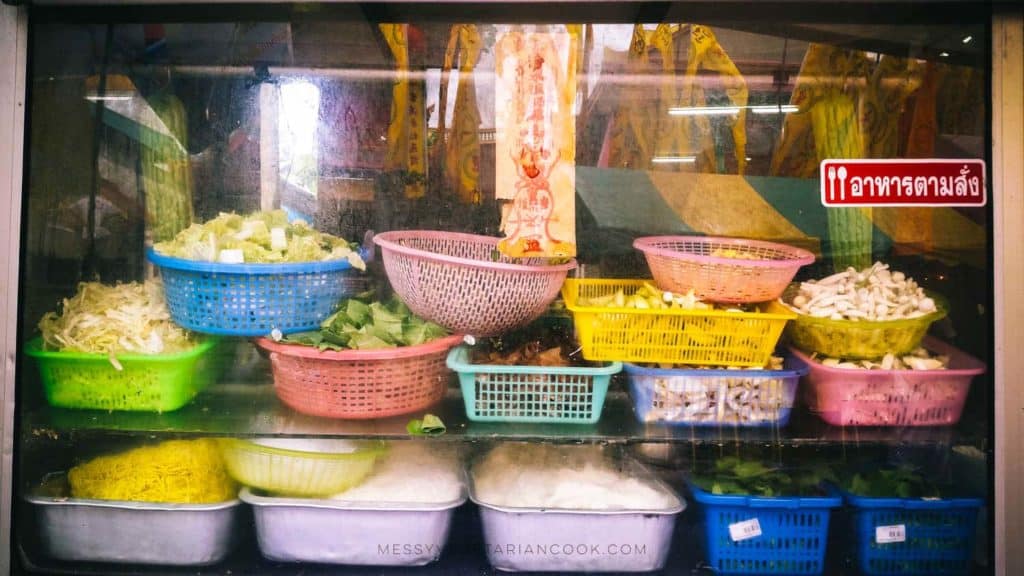
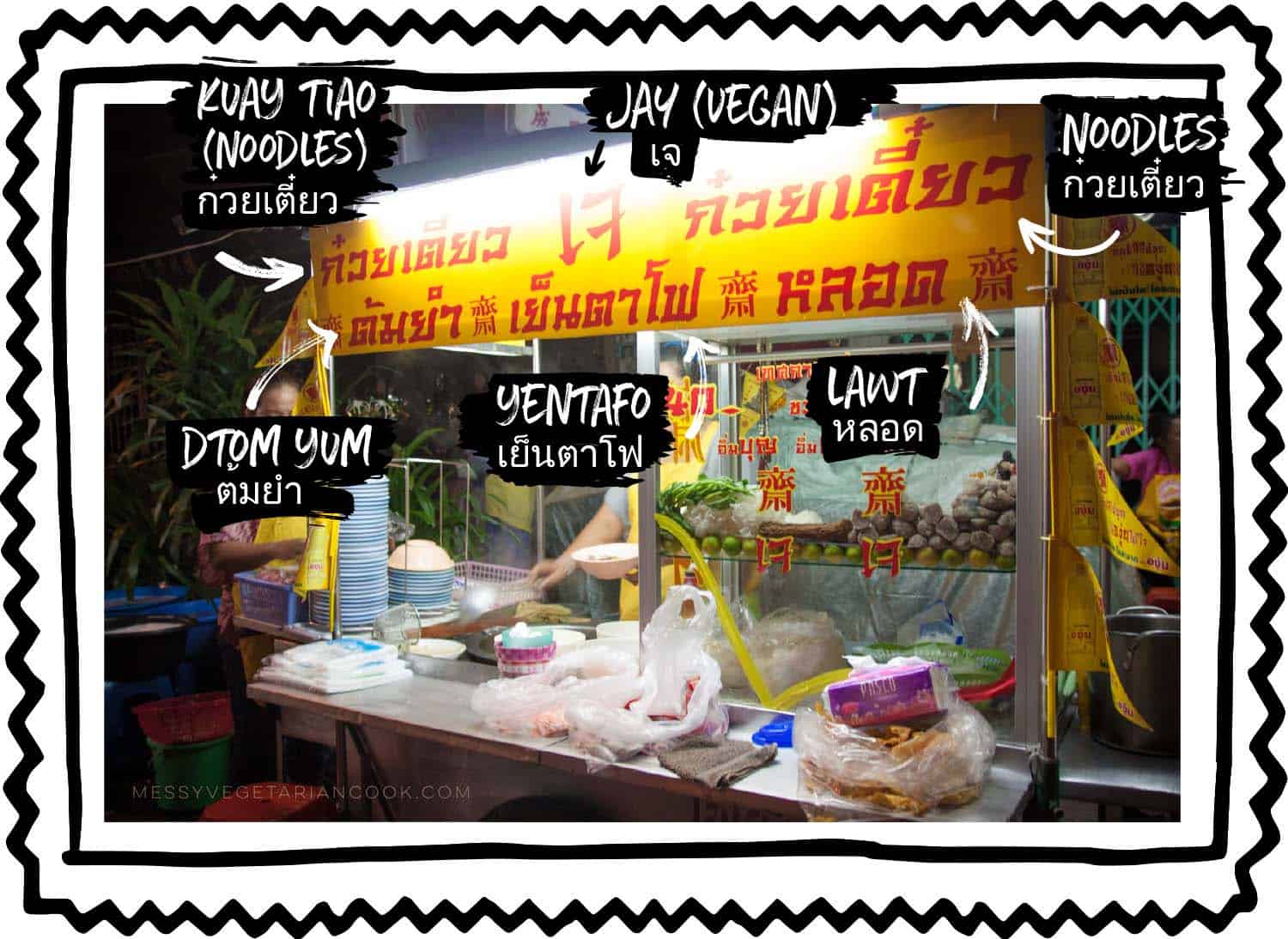
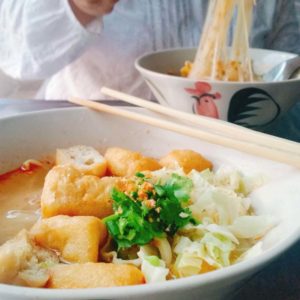
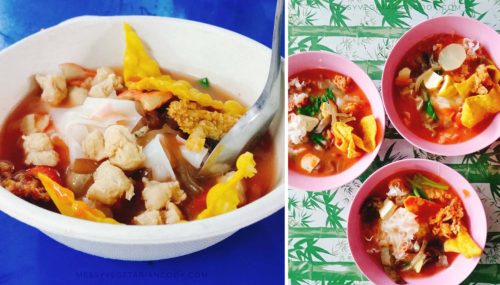
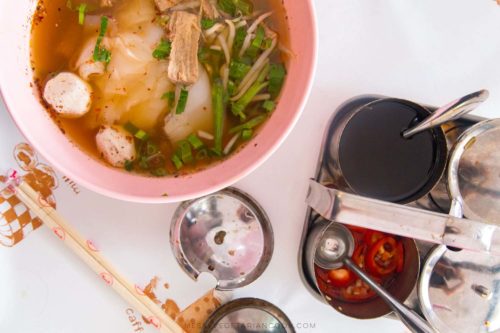
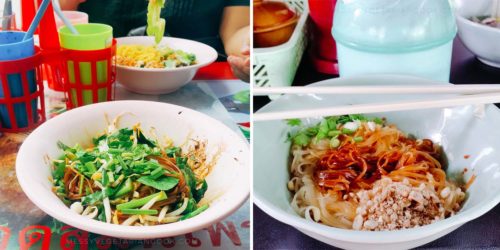
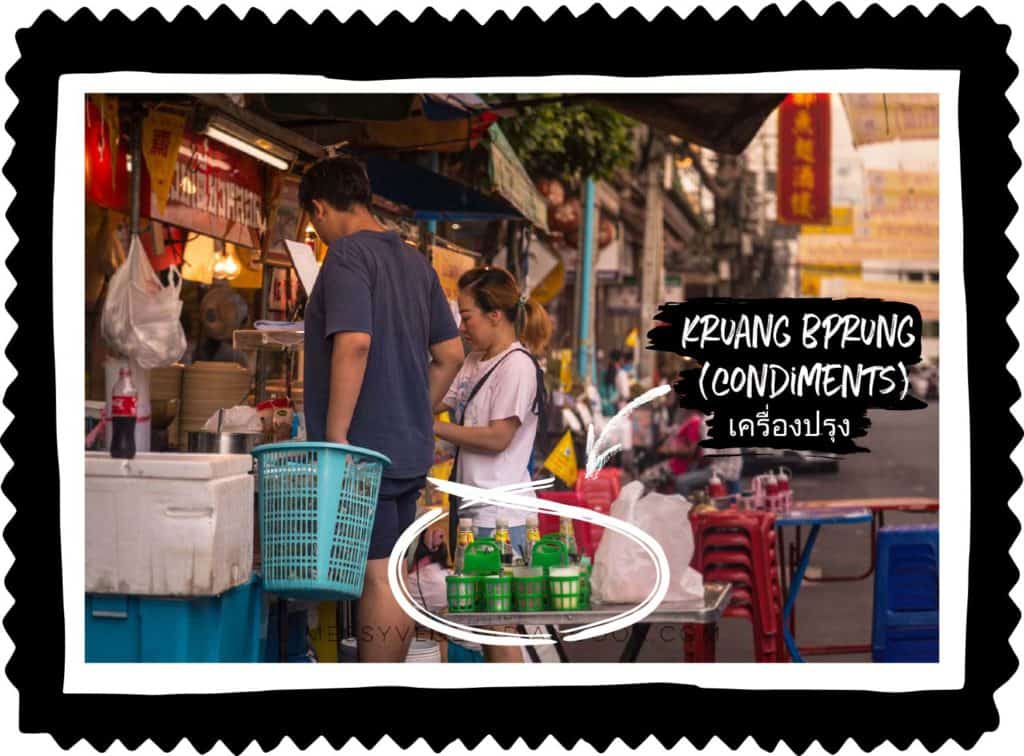
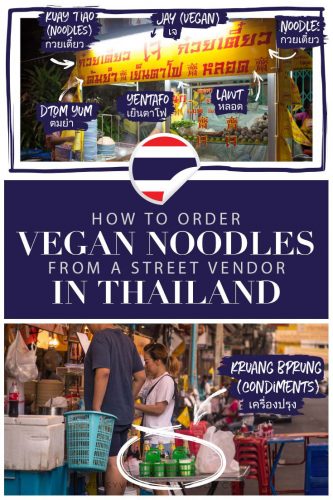


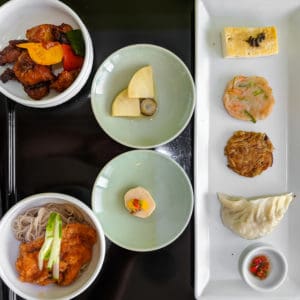
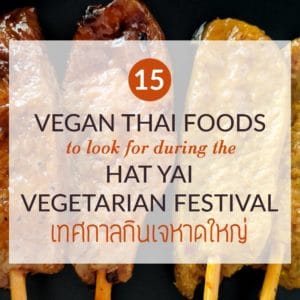
Jose Dihiansan says
This is a nice guide to eat noodles in Thailand! i really love it how you explained it using pictures and the very deep explanation of the different kinds of broths. Thanks for this Vegan Street noodles food guide!
I reserve the right to improve malicious and trollish comments.